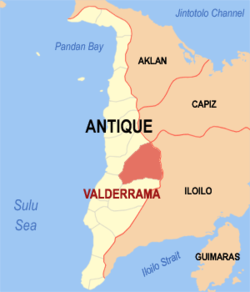
Balete, officially the Municipality of Balete, is a 4th class municipality in the province of Aklan, Philippines. According to the 2020 census, it has a population of 30,090 people.

Buruanga, officially the Municipality of Buruanga, is a 5th class municipality in the province of Aklan, Philippines. It is the farthest town of Aklan from its provincial capital. According to the 2020 census, it has a population of 19,357 people.

Madalag, officially the Municipality of Madalag, is a 4th class municipality in the province of Aklan, Philippines. It is Aklan's largest municipality by land area and also the most sparsely populated. According to the 2020 census, it has a population of 18,890 people.

Anini-y, officially the Municipality of Anini-y, is a 4th class municipality in the province of Antique, Philippines. According to the 2020 census, it has a population of 22,018 people. Making it 14th most populous municipality in the province of Antique.

Barbaza, officially the Municipality of Barbaza, is a 4th class municipality in the province of Antique, Philippines. According to the 2020 census, it has a population of 23,359 people.

Belison, officially the Municipality of Belison, is a 5th class municipality in the province of Antique, Philippines. According to the 2020 census, it has a population of 14,129 people. Making it 18th most populous, the smallest municipality in the province of Antique and the smallest in Panay island in both area and population.

Bugasong, officially the Municipality of Bugasong, is a 3rd class municipality in the province of Antique, Philippines. According to the 2020 census, it has a population of 34,676 people. Making it 8th most populous municipality in the province of Antique and fourth largest municipality in terms of land area, with a total area of 203.71 square kilometers.
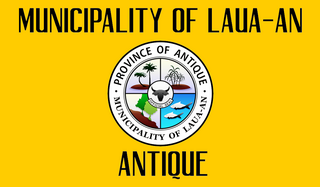
Laua-an, officially the Municipality of Laua-an, is a 4th class municipality in the province of Antique, Philippines. According to the 2020 census, it has a population of 26,580 people. Making it 12th most populous municipality in the province of Antique. Laua-an celebrates its Pahinis Festival every January.

Libertad, officially the Municipality of Libertad,, is a 5th class municipality in the province of Antique, Philippines. According to the 2020 census, it has a population of 17,507 people, making it the 17th most populous municipality in the province of Antique.

Patnongon, officially the Municipality of Patnongon, is a 3rd class municipality in the province of Antique, Philippines. According to the 2020 census, it has a population of 38,329 people.

San Jose de Buenavista, officially the Municipality of San Jose de Buenavista,, is a 1st class municipality and capital of the province of Antique, Philippines. According to the 2020 census, it has a population of 65,140 people, making it the most populous municipality in the province of Antique. It is often referred to by locals as simply San Jose.

Sebaste, officially the Municipality of Sebaste, is a 4th class municipality in the province of Antique, Philippines. According to the 2020 census, it has a population of 18,816 people. Making it 16th most populous municipality in the province of Antique.

Sibalom, officially the Municipality of Sibalom,, is a 2nd class municipality in the province of Antique, Philippines. According to the 2020 census, it has a population of 63,833 people. Making it second most populous municipality in the province of Antique and fifth largest municipality in terms of land area, with a total area of 201.30 square kilometers.
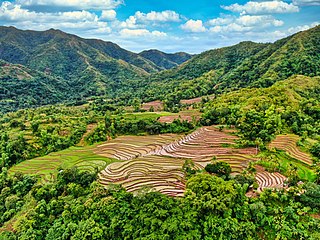
Tibiao, officially the Municipality of Tibiao, is a 4th class municipality in the province of Antique, Philippines. According to the 2020 census, it has a population of 28,703 people.
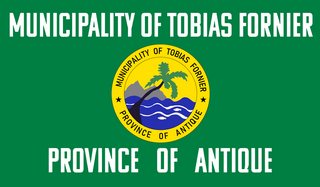
Tobias Fornier, officially the Municipality of Tobias Fornier,, is a 4th class municipality in the province of Antique, Philippines. According to the 2020 census, it has a population of 33,816 people, making it the ninth most populous municipality in the province of Antique.

Jamindan, officially the Municipality of Jamindan, is a 2nd class municipality in the province of Capiz, Philippines. According to the 2020 census, it has a population of 38,670 people.

Sapian, officially the Municipality of Sapian, and sometimes spelled Sapi-an, is a 4th class municipality in the province of Capiz, Philippines. According to the 2020 census, it has a population of 26,697 people. It is 27 kilometres (17 mi) from Roxas City, the provincial capital.

Tapaz, officially the Municipality of Tapaz, is a 1st class municipality in the province of Capiz, Philippines. According to the 2020 census, it has a population of 54,423 people.
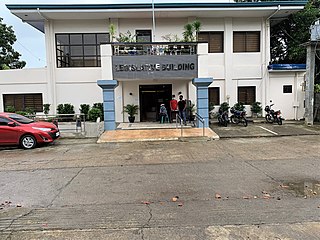
Anilao, officially the Municipality of Anilao, is a 4th class municipality in the province of Iloilo, Philippines. According to the 2020 census, it has a population of 30,520 people.

Maasin, officially the Municipality of Maasin, is a 3rd class municipality in the province of Iloilo, Philippines. According to the 2020 census, it has a population of 38,461 people.
